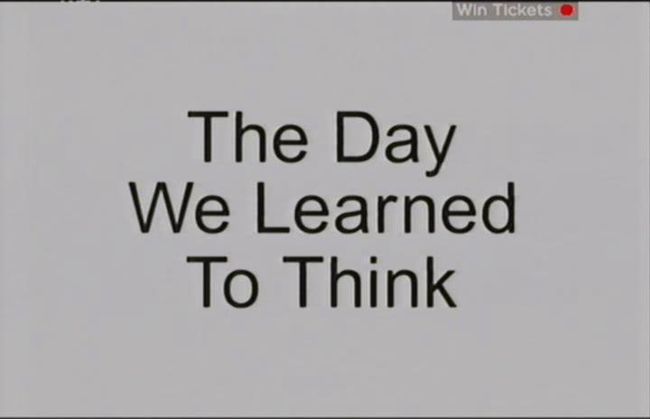中文名稱(Chinese name):
思想之始
別名(Alias):
我們學會思考的那一天
英文名稱(English name):
The Day We Learned to Think
講 述 者(narrator):
約翰·夏普尼爾(John Shrapnel)
制片人/導演(producer / director):
丹·克裏夫頓(Dan Clifton)
顧問(Consultant):
克裏斯·亨施伍德(Chris Henshilwood)
理查德·克萊恩(Richard Klein)
艾利森·布魯克斯(Alison Brooks)
特倫斯·迪肯(Terrence Deacon)
蘭德爾·懷特(Randall White)
讓-雅克·於布蘭(Jean-Jacques Hublin)
傑弗雷·萊特曼(Jeffrey Laitman)
瑪格麗特·克萊格(Margaret Clegg)
弗朗西斯·德埃裏克(Francesco D'Errico)
制作公司(Production company):
英國國家廣播公司(BBC)教育和培訓(BBC Education & Training)
英國廣播公司(British Broadcasting Corporation)
英國廣播公司資源部(公司)(BBC Active (Firm))
出版者(Publisher):
[聯合王國][United Kingdom]:
英國廣播公司資源部(公司)(BBC Active (Firm))
漢密爾頓(Hamilton)
發行人(Distributed ):
人文與科學電影公司[2008](Films for Humanities & Sciences, [2008])
影片類型(Film type):
自然曆史/考古類紀錄片(Natural history / archaeological documentary)
版本/格式(Edition/Format):
DVD視頻(DVD video)
發布日期(Release date):
2008年(英國)
影片數目(Number of films):
單一集
地區(Area):
英國
語言(Language):
英語
技術規格(Technical Specs):
視頻編解碼器(Video Codec):DivX 5
視頻比特率(Video Bitrate):1195 kb / s
視頻分辨率(Video Resolution):720 x 464
音頻編解碼器(Audio Codec):MP3
音頻比特率(Audio BitRate):160 kb / s
音頻語言(Audio Languages):英語(English)
字幕(Subtitles):無(None)
運行時間(RunTime Per Part):46分鐘(46 min)
文件大小(Part Size):450MB
播放日期(Playback date):
在2003年第一次播出,作為地平線(Horizon)電視節目的一部分。英國廣播公司二臺,2月20日星期四晚上9點。
Originally broadcast in 2003 as part of the television program, Horizon. BBC Two, Thursday 20 February, 9pm.
由約翰·夏普尼爾(John Shrapnel)主持的並由英國廣播公司(BBC)出版的曆史紀錄片作為英國廣播公司(BBC)地平線系列2003年的一部分進行播放。
人物簡介(Character profile):
約翰·夏普尼爾(John Shrapnel)
約翰·夏普尼爾出生在伯明翰,是諾曼和米範維·施雷普內爾的兒子。他是在斯托克波特和南倫敦長大的,就讀於倫敦城市學院和劍橋大學。他曾經是國家青年劇院的一名成員,在劇院工作過,特別是皇家莎士比亞劇團和國家劇院。他目前居住在薩福克和倫敦。
John Shrapnel was born in Birmingham, the son of Norman and Myfanwy Shrapnel. He was brought up in Stockport and south London, attending City of London School and Cambridge University. He was an original member of the National Youth Theatre and has worked extensively in theatre, particularly the Royal Shakespeare Company and National Theatre. He lives in Suffolk and London.
節目摘要(Programme summary):
了解人類最早的曆史往往來自於化石的研究,它們告訴我們很多關於我們之前人類生活的情況。有一件事是化石無法告訴我們的,在什麼時候我們中斷了日常生活方式並開始象征性地思考,這是代表我們的環境和我們如何改變它的想法嗎?
在南非的一次挖掘中,發現了一件七萬年前的紅色赭石,它向我們提出了一些非常有趣的問題。解剖學意義上的現代人類(智人)大約在10萬年前就在非洲出現了。我們從化石證據中得知,智人取代了他們周圍的其他原始人,並從非洲遷移到亞洲和中東,在4萬年前到達欧洲。
理查德·克萊恩教授認為,藝術是人類進化的裏程碑。毫無疑問,這是一種廣泛而普遍的藝術,表明你正在和我們這樣的人打交道。畢竟,沒有其他動物能夠把一幅畫定義為一種顏色和形狀的集合。這種能力是人類獨有的。其他科學家也同意這樣的觀點。他們認為藝術可以將人類定義為在行為上的現代人類,它的開始必須與能夠實現說話和使用語言的能力相一致。如果有人以想象力用藝術的形式來描述他們生活環境的共享方式,那麼他們就無法擁有語言和言語,這似乎是不可想象的。人類與動物最大的分別,除了可以賺錢外,人類懂得思考、溝通,有自己的一套語言。一直以來,科學家相信,語言的發展大概只有四萬年曆史。四萬年前的人類就好像嬰孩般只懂牙牙學語,與其他動物無異。不過,當一些科學家發現了八萬年前的寫作工具和圖畫後,人類語言的發展過程再次惹來爭議。最近,他們更將語言的發展時間推前至二十萬年以前。到底科學家的推論有何憑據?二十萬年以來,語言的進化過程又是怎樣?
Understanding of humans' earliest past often comes from studying fossils. They tell us much of what we know about the people who lived before us. There is one thing fossils cannot tell us, at what point did we stop living day - to-day and start to think symbolically, to represent ideas about our environment and how we could change it?
At a dig in South Africa the discovery of a small piece of ochre pigment, 70,000 years old, has raised some very interesting questions. Anatomically modern humans (Homo sapiens) emerged in Africa roughly 100,000 years ago. We know from fossil evidence that Homo sapiens replaced other hominids around them and moved out of Africa into Asia and the Middle East, reaching Europe 40,000 years ago.
Prof Richard Klein believes art is a landmark in human evolution. Unquestionable art that's widespread and common suggests you're dealing with people just like us. No other animals, after all, are able to define a painting as anything other than a collection of colours and shapes. This ability is unique to humans. Other scientists agree. They believe art defines humans as behaviourally modern, and its beginning must coincide with the ability to speak and use language. If someone has the imagination to devise a shared way to describe their environment using art then it seems inconceivable that they could not possess language and speech.
The biggest difference between humans and animals is that, apart from making money, humans can think, communicate and have their own set of languages. Scientists have long believed that the development of language is only about 40,000 years old. Forty thousand years ago, human beings were like babies who knew nothing but teeth, and were indistinguishable from any other animal. However, when some scientists discovered writing tools and drawings 80,000 years ago, the development of human language was once again controversial. More recently, they have pushed the development of language to 200,000 years ago. What is the evidence of the scientists' reasoning? How has language evolved over the last 200,000 years?
文字:《傑特遜工作室》(JENTSON STUDIO) 制作
視頻:《傑特遜工作室》(JENTSON STUDIO) 紀錄片數據庫BBC-021號
翻譯:趙永安


